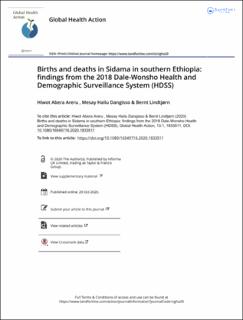| dc.description.abstract | Background: Sidama is one of the most densely populated areas in Ethiopia. Information about the demographic characteristics is scarce, and most studies were census based on interviews. Earlier population studies from Ethiopia did not sufficiently address the validity of measuring births, deaths, and age-composition.
Objective: To investigate the population characteristics in Sidama with an emphasis on fertility estimates, age, and death reporting.
Methods: This is a mixed-method cross-sectional study, conducted in Sidama in southern Ethiopia, using baseline data of newly established Dale-Wonsho Health and Demographic Surveillance System site in 2018. We used quantitative data of 5179 randomly selected households having 25,144 individuals. We collected information on deaths in the same study period and population from the traditional burial associations (Iddir). Qualitative data were collected using focus group discussions, and in-depth interviews. Life tables, age reliability indices and logistic regression were used to analyse the data.
Results: The total fertility rate was 2.9 children/woman, the crude birth rate was 22.8/1000 population and the crude death rate was 5.2/1000 population. The dependency ratio was 66/ 100 working-age population. Urban residents had higher birth rates (OR = 1.4 (95% CL: 1.05–1.78), and women with basic education had lower birth rates (OR = 0.6 (95% CL: 0.46–0.78) compared to those with no education. The age accuracy indices showed unreliable age reporting. The number of deaths increased from 29 to 132 when death reports from the Iddirs were included. There was under-reporting of neonatal and deaths of young children. Substituting national and regional mortality estimates, the life expectancy declined to an average of 53 years (range 48–58 years).
Conclusion: The fertility rate in Sidama is lower than previously reported and is affected by age, residence and education. As we have identified important measurement and reporting errors, future demographic surveillance sites should consider these limitations. | en_US |

